Spring and Early Summer Swarms
By Zachary Ciras on May 8, 2025.
As spring awakens in New England, the warming temperatures and blooming landscapes herald the return of swarming insects. From termites to mosquitoes, these creatures play vital ecological roles but can pose significant challenges when they invade homes, gardens, or outdoor spaces. This blog post explores the behaviors, infestation risks, and management strategies for key swarming insects in New England during spring and early summer, including termites, carpenter ants, citronella ants, other small ants, wasps, carpenter bees, stoneflies, lacewings, fruit and vegetable pests, midges, and biting flies. We’ll also contrast their natural behaviors with professional pest control perspectives to help you decide when to act.
Wood-Destroying Insects and Nuisance Ants
Termites
In New England, eastern subterranean termites (Reticulitermes flavipes) are the primary culprits of spring swarming. From April to June, winged reproductive termites (alates) emerge in large numbers to establish new colonies. These swarms are often mistaken for flying ants, but termites have straight antennae, equal-length wings, and no pinched waist. Termites are highly destructive, feeding on cellulose in wood and causing an estimated $5 billion in U.S. property damage annually. Infestations often go unnoticed until significant structural damage occurs, as they work hidden within walls or foundations.
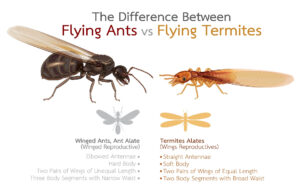
Infographic illustration of difference between flying ants vs flying termites
Prevention and Control: Seal cracks in foundations, reduce wood-to-soil contact, and maintain proper drainage to deter termites. DIY treatments rarely address hidden colonies and their cryptobiotic behavior tends to hide infestations from being discovered. If swarms are spotted indoors, immediate professional intervention is warranted. Also look for ‘mud’ shelter tubes connecting the colony in the soil to the wood work sites worker termites are traveling to.
Carpenter Ants
Carpenter ants (Camponotus spp.) also swarm in spring, typically May to June, as winged reproductives seek new nesting sites. Unlike termites, carpenter ants don’t eat wood but excavate it to create galleries, often targeting damp or decaying wood in homes. Their large size (up to ½ inch), bent antennae, and uneven wings distinguish them from termites. Infestations can weaken structural timbers, especially in moist areas like basements or around leaks. 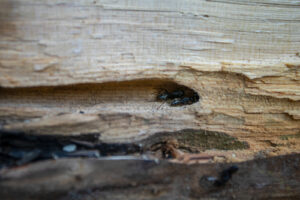
Prevention and Control: Eliminate moisture sources, such as leaky pipes, and remove rotting wood near homes. Baiting systems and perimeter treatments by professionals are effective for established infestations. Homeowners can use ant baits but should avoid sprays that disrupt bait trails. Professional services are often required to eliminate nesting as well as provide a lasting, effective barrier to prevent against recurring infestations.
Carpenter Bees: Springtime Borers
Carpenter bees (Xylocopa virginica) are active in New England from April to June, drilling perfectly round holes into untreated wood (decks, eaves, or fences) to create nesting tunnels. Males hover aggressively but lack stingers, while females sting only if provoked. Their swarming is minimal, but their boring can weaken wooden structures over time, and their holes attract woodpeckers, causing further damage.
Prevention and Control: Paint or seal wooden surfaces, as carpenter bees prefer untreated wood. Fill existing holes with caulk or wood putty after treating with insecticide. Professional treatments may be needed for persistent activity. Tolerating a few bees is reasonable, as their ecological role as pollinators outweighs minor damage in many cases. 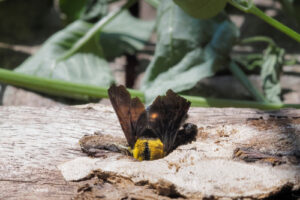
Citronella Ants
Citronella ants (Lasius claviger) are less destructive but notable for their spring swarming, often indoors. These small, yellowish ants emit a lemony odor when crushed, earning their name. They nest underground near foundations and swarm in late spring (May to early June). While they don’t damage structures, their presence can be alarming, especially when winged alates invade homes.
Prevention and Control: Seal entry points and maintain clean indoor spaces. Citronella ants rarely require professional treatment, as they don’t nest indoors long-term. Vacuuming swarms and addressing outdoor nests with boiling water can suffice.
Small Ants: Odorous House Ants and Pavement Ants
Odorous house ants (Tapinoma sessile) and pavement ants (Tetramorium caespitum) are common nuisance pests in New England. Odorous house ants, small and dark brown, swarm in spring and invade homes seeking sweets, emitting a rotten coconut odor when crushed. Pavement ants, also small and dark, nest under sidewalks or driveways and swarm in early summer, often entering homes for food. Neither causes structural damage, but their persistence can frustrate homeowners.
Prevention and Control: Keep kitchens clean, store food in sealed containers, and seal cracks. Baits are effective for both species, as workers carry poison back to colonies. OTC Sprays may provide temporary relief but often fail to eliminate nests, so professional help may be needed for target active nests and develop a program to prevent future infestations.
Comparison and Infestation Potential: Termites pose the greatest threat due to their wood-destroying habits, requiring urgent professional action. Carpenter ants also demand attention for structural risks, while citronella, odorous house, and pavement ants are primarily nuisances. Early detection is key: termite and carpenter ant infestations can cost thousands to repair, while small ants are more manageable unless colonies persist. Preventative maintenance can prevent many of these issues.
Wasp Activity: Foraging vs. Cause for Concern
Wasps, particularly yellowjackets (Vespula spp.) and paper wasps (Polistes spp.), become active in spring as queens emerge to establish nests. By early summer, colonies grow, and workers forage aggressively for protein and sugars. Swarming behavior is less common than with ants or termites; instead, wasps are often seen in groups near food sources, garbage, or nesting sites like eaves or trees. Their bold foraging can intimidate, especially at picnics or outdoor events.
 From a pest control professional’s perspective, wasp activity warrants concern when nests are near high-traffic areas, such as doorways or playgrounds, due to sting risks. A single yellowjacket nest can house thousands, and their aggression peaks in late summer. Paper wasps are less aggressive but still pose risks for allergic individuals. Professionals advise against DIY nest removal, as disturbing a nest can provoke attacks.
From a pest control professional’s perspective, wasp activity warrants concern when nests are near high-traffic areas, such as doorways or playgrounds, due to sting risks. A single yellowjacket nest can house thousands, and their aggression peaks in late summer. Paper wasps are less aggressive but still pose risks for allergic individuals. Professionals advise against DIY nest removal, as disturbing a nest can provoke attacks.
Prevention and Control: Secure trash cans, clean up food spills, and inspect eaves or sheds for early nests in spring. If a nest is found, professional removal is safest, using targeted insecticides or physical extraction. For minor foraging, traps can reduce numbers, but they don’t eliminate colonies. Tolerate distant nests if they pose no immediate threat, as wasps control other pests.
Other Swarming Insects
Stoneflies
Stoneflies (Plecoptera) are aquatic insects that emerge in spring, swarming near rivers and streams. Their mass emergences are ecologically vital, signaling clean water, but they can be a nuisance when they cover buildings or lights. They don’t bite or invade homes. 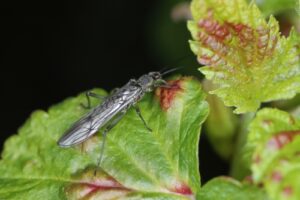
Prevention and Control: Reduce outdoor lighting at night to deter swarms. No control is typically needed, as stoneflies are harmless and short-lived.
Lacewings
Lacewings (Chrysopidae) are beneficial insects that swarm in early summer, attracted to lights. Their delicate green wings and predatory larvae (which eat aphids) make them garden allies. They pose no threat to humans or structures.
Prevention and Control: Tolerate lacewings, as they naturally control pests. Dim lights to reduce swarming near homes.
Fruit and Vegetable Pests
Insects like aphids, flea beetles, and cabbage worms swarm gardens in spring, targeting crops. Aphids suck plant sap, flea beetles chew holes in leaves, and cabbage worms devastate brassicas. Their rapid reproduction can decimate gardens if unchecked.
Prevention and Control: Use row covers, introduce beneficial insects like ladybugs, or apply neem oil. Regular inspection and removal of affected plants help. Tolerate minor damage to support ecosystem balance.
Midges
Midges (Chironomidae) swarm in spring near water, resembling mosquitoes but lacking bites. Their clouds can annoy outdoor enthusiasts and clog screens or lights. 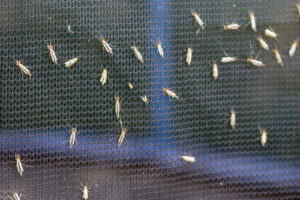
Prevention and Control: Use screens and reduce standing water. No chemical control is needed; tolerate swarms, as they’re harmless and transient.
Biting Flies: Mayflies and Mosquitoes
Mayflies (Ephemeroptera) swarm briefly in late spring near water, living only days as adults. They’re harmless but can litter surfaces during mass emergences. Mosquitoes (Culicidae), however, are a major concern, swarming in damp areas and transmitting diseases like West Nile virus. Both are most active at dusk.
Prevention and Control: For mayflies, reduce lighting and tolerate short-lived swarms. For mosquitoes, eliminate standing water, use repellents (DEET or picaridin), and install screens. Professional fogging or larvicides may be needed for severe mosquito issues.
Conclusion
New England’s spring and early summer bring a diverse array of swarming insects, each with unique behaviors and impacts. Termites and carpenter ants demand vigilance due to their destructive potential, while citronella and small ants are more nuisance than threat. Wasps and carpenter bees require cautious management near human activity, and other swarming insects like stoneflies, lacewings, and midges are best tolerated for their ecological roles. Mosquitoes stand out as health risks, necessitating proactive control. By understanding these insects’ habits and applying targeted prevention—sealing entry points, reducing moisture, or using baits and repellents—homeowners can minimize conflicts. For severe infestations, professional pest control ensures safety and efficacy, preserving both property and peace of mind in New England’s vibrant springtime.